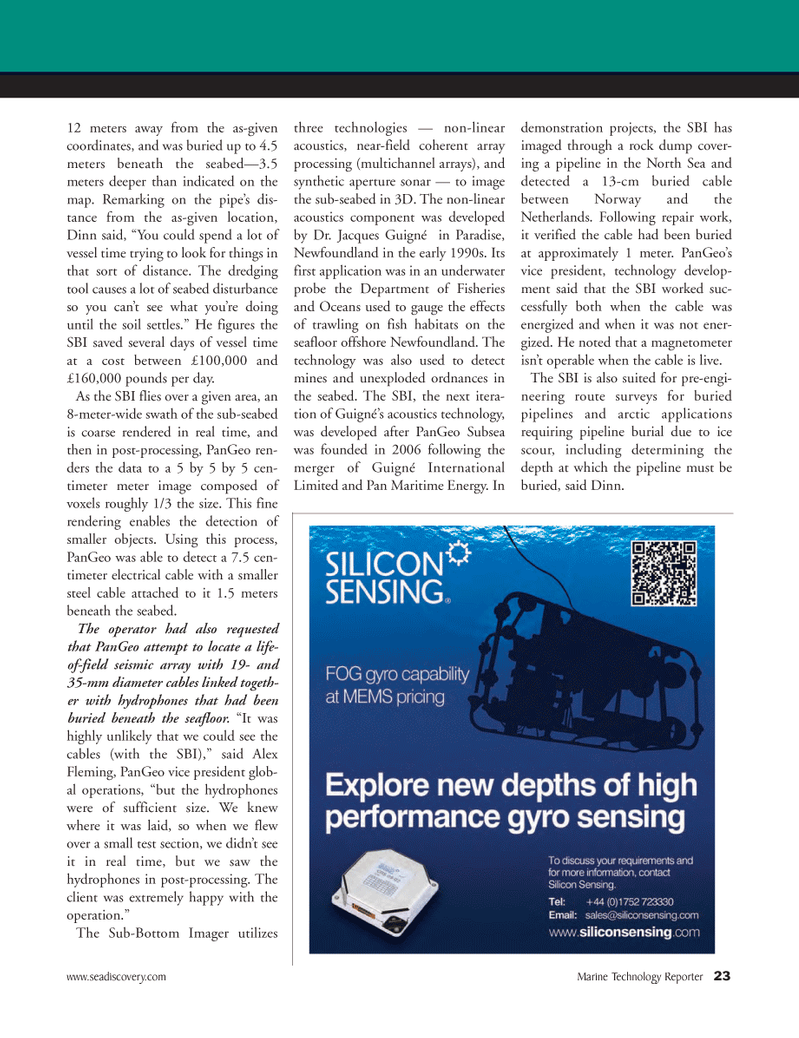
Page 23: of Marine Technology Magazine (October 2011)
Ocean Engineering & Design
Read this page in Pdf, Flash or Html5 edition of October 2011 Marine Technology Magazine
12 meters away from the as-given coordinates, and was buried up to 4.5 meters beneath the seabed?3.5meters deeper than indicated on themap. Remarking on the pipe?s dis- tance from the as-given location, Dinn said, ?You could spend a lot of vessel time trying to look for things in that sort of distance. The dredging tool causes a lot of seabed disturbanceso you can?t see what you?re doing until the soil settles.? He figures the SBI saved several days of vessel time at a cost between £100,000 and £160,000 pounds per day. As the SBI flies over a given area, an 8-meter-wide swath of the sub-seabedis coarse rendered in real time, and then in post-processing, PanGeo ren- ders the data to a 5 by 5 by 5 cen- timeter meter image composed ofvoxels roughly 1/3 the size. This fine rendering enables the detection of smaller objects. Using this process, PanGeo was able to detect a 7.5 cen- timeter electrical cable with a smallersteel cable attached to it 1.5 metersbeneath the seabed. The operator had also requested that PanGeo attempt to locate a life- of-field seismic array with 19- and35-mm diameter cables linked togeth-er with hydrophones that had been buried beneath the seafloor. ?It was highly unlikely that we could see the cables (with the SBI),? said AlexFleming, PanGeo vice president glob- al operations, ?but the hydrophones were of sufficient size. We knew where it was laid, so when we flew over a small test section, we didn?t see it in real time, but we saw the hydrophones in post-processing. The client was extremely happy with the operation.?The Sub-Bottom Imager utilizes three technologies ? non-linear acoustics, near-field coherent array processing (multichannel arrays), and synthetic aperture sonar ? to image the sub-seabed in 3D. The non-linear acoustics component was developed by Dr. Jacques Guigné in Paradise, Newfoundland in the early 1990s. Its first application was in an underwater probe the Department of Fisheries and Oceans used to gauge the effects of trawling on fish habitats on theseafloor offshore Newfoundland. The technology was also used to detectmines and unexploded ordnances in the seabed. The SBI, the next itera- tion of Guigné?s acoustics technology, was developed after PanGeo Subsea was founded in 2006 following the merger of Guigné International Limited and Pan Maritime Energy. In demonstration projects, the SBI has imaged through a rock dump cover- ing a pipeline in the North Sea and detected a 13-cm buried cablebetween Norway and the Netherlands. Following repair work, it verified the cable had been buried at approximately 1 meter. PanGeo?s vice president, technology develop- ment said that the SBI worked suc- cessfully both when the cable wasenergized and when it was not ener- gized. He noted that a magnetometer isn?t operable when the cable is live. The SBI is also suited for pre-engi- neering route surveys for buried pipelines and arctic applications requiring pipeline burial due to ice scour, including determining the depth at which the pipeline must beburied, said Dinn. www.seadiscovery.com Marine Technology Reporter 23MTR#8 (18-33):MTR Layouts 10/10/2011 2:02 PM Page 23

 22
22

 24
24
